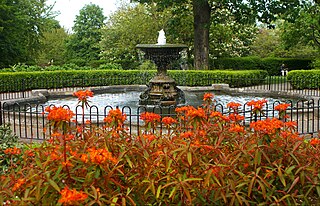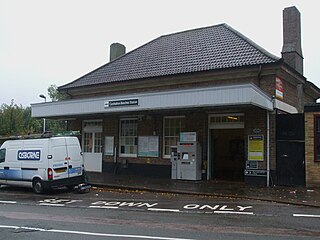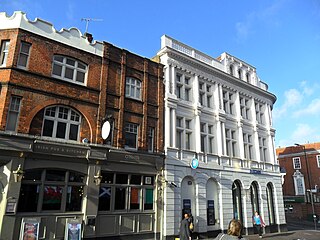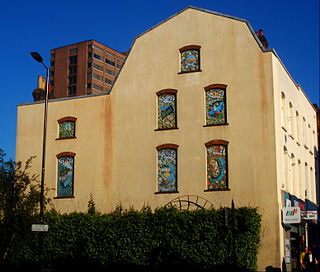
The London Borough of Croydon is a London borough in south London, part of Outer London. It covers an area of 87 km2 (33.6 sq mi). It is the southernmost borough of London. At its centre is the historic town of Croydon from which the borough takes its name; while other urban centres include Coulsdon, Purley, South Norwood, Norbury, New Addington, Selsdon and Thornton Heath. Croydon is mentioned in Domesday Book, and from a small market town has expanded into one of the most populous areas on the fringe of London. The borough is now one of London's leading business, financial and cultural centres, and its influence in entertainment and the arts contribute to its status as a major metropolitan centre. Its population is 390,719, making it the largest London borough and sixteenth largest English district.

Carshalton is a town, with a historic village centre, in south London, England, within the London Borough of Sutton. It is situated 9.5 miles (15.3 km) south-southwest of Charing Cross, in the valley of the River Wandle, one of the sources of which is Carshalton Ponds in the middle of the village. Prior to the creation of Greater London in 1965, Carshalton was in the administrative county of Surrey.

Wallington is a town in the London Borough of Sutton, South London, England, 9.7 miles (15.6 km) south-west of Charing Cross. Before the Municipal Borough of Beddington and Wallington merged into the London Borough of Sutton in Greater London in 1965, it was part of the county of Surrey. Wallington is a post town in the SM postcode area.

The London Borough of Sutton is an Outer London borough in south-west London, England. It covers an area of 43 km2 (17 sq mi) and is the 80th largest local authority in England by population. It borders the London Borough of Croydon to the east, the London Borough of Merton to the north and the Royal Borough of Kingston upon Thames to the north-west; it also borders the Surrey boroughs of Epsom and Ewell to the west and Reigate and Banstead to the south. The local authority is Sutton London Borough Council. Its principal town is the eponymous Sutton.

Croydon is a large town in South London, England, 9.3 miles (15.0 km) south of Charing Cross. Part of the London Borough of Croydon, a local government district of Greater London, it is one of the largest commercial districts in Greater London, with an extensive shopping district and night-time economy. The entire town had a population of 192,064 as of 2011, whilst the wider borough had a population of 384,837.

The River Wandle is a right-bank tributary of the River Thames in south London, England. With a total length of about 9 miles (14 km), the river passes through the London boroughs of Croydon, Sutton, Merton and Wandsworth, where it reaches the Thames. A short headwater – the Caterham Bourne – is partially in Surrey, the historic county of the river's catchment. Tributaries of the Wandle include Carshalton Ponds and Norbury Brook.

Sutton is the principal town in the London Borough of Sutton in South London, England. It is the administrative headquarters of the Outer London borough, on the lower slopes of the North Downs. It is 10 miles (16 km) south-southwest of Charing Cross, one of the thirteen metropolitan centres in the London Plan. The population of the town was counted as 41,483 in the 2011 census, while the borough overall counted 204,525.

Carshalton Beeches railway station is in south Carshalton in the London Borough of Sutton in south London. The station, and all trains serving it, is operated by Southern, and is in Travelcard Zone 5. It is between Wallington and Sutton, 13 miles 72 chains down the line from London Bridge, measured via Forest Hill.

The London Government Act 1963 is an Act of the Parliament of the United Kingdom, which created Greater London and a new local government structure within it. The Act significantly reduced the number of local government districts in the area, resulting in local authorities responsible for larger areas and populations. The upper tier of local government was reformed to cover the whole of the Greater London area and with a more strategic role; and the split of functions between upper and lower tiers was recast. The Act classified the boroughs into inner and outer London groups. The City of London and its corporation were essentially unreformed by the legislation. Subsequent amendments to the Act have significantly amended the upper tier arrangements, with the Greater London Council abolished in 1986, and the Greater London Authority introduced in 2000. As of 2016, the London boroughs are more or less identical to those created in 1965, although with some enhanced powers over services such as waste management and education.

Carshalton Athletic Football Club is an English football club based in Carshalton in the London Borough of Sutton. They currently play in the Isthmian League Premier Division and are based at the War Memorial Sports Ground. The club also field a women's team playing in the London and South East Regional Women's Premier Division and have one of the biggest community clubs in England with over 40 junior teams.

St Helier Hospital in the London Borough of Sutton is run by Epsom and St Helier University Hospitals NHS Trust along with Epsom Hospital. It is located next to the large St Helier council estate and close to the major intersection known as Rosehill.
Bioregional is a British entrepreneurial charity, which aims to invent and deliver practical solutions for sustainability. It was founded in 1992 on the belief that overconsumption of resources was the driving force behind environmental degradation, and set out to find new ways for people to meet more of their needs from local resources.

Sutton High Street is a high street running north–south through the town of Sutton in the London Borough of Sutton.

The Spinney, Carshalton is a 0.4 hectare local nature reserve in Carshalton in the London Borough of Sutton, England. It is owned by Sutton Council and managed by the council and Sutton Nature Conservation Volunteers. It used to be managed by the London Wildlife Trust.

The Secombe Theatre was a theatre in Cheam Road, Sutton, Greater London. The theatre was opened in 1983 by the Welsh comedian Sir Harry Secombe, who lived in Sutton for over 30 years, and was named after him. The theatre went into administration and closed in August 2016. A petition to save Sutton's theatres was run in late 2016, gaining 1,350 signatures.

The Millennium Dial Armillary is one of six pieces of public art located in the town centre of Sutton in Greater London, England. The others include the Sutton heritage mosaic, the Sutton twin towns mural and the Messenger statue.

The Sutton Twin towns mural is a large mural in the form of seven individual paintings situated in Sutton High Street in the town of Sutton in Greater London, England. It is one of six works of public art in Sutton town centre.

Elliot Haydn George Colburn is a British Conservative Party politician. He has been the Member of Parliament (MP) for Carshalton and Wallington since the 2019 general election. Colburn also served as councillor for the Cheam ward on Sutton Council from 2018 to 2022.
The 2022 Sutton London Borough Council election took place on 5 May 2022. All 55 members of Sutton London Borough Council were elected. The elections took place alongside local elections in the other London boroughs and elections to local authorities across the United Kingdom.



















